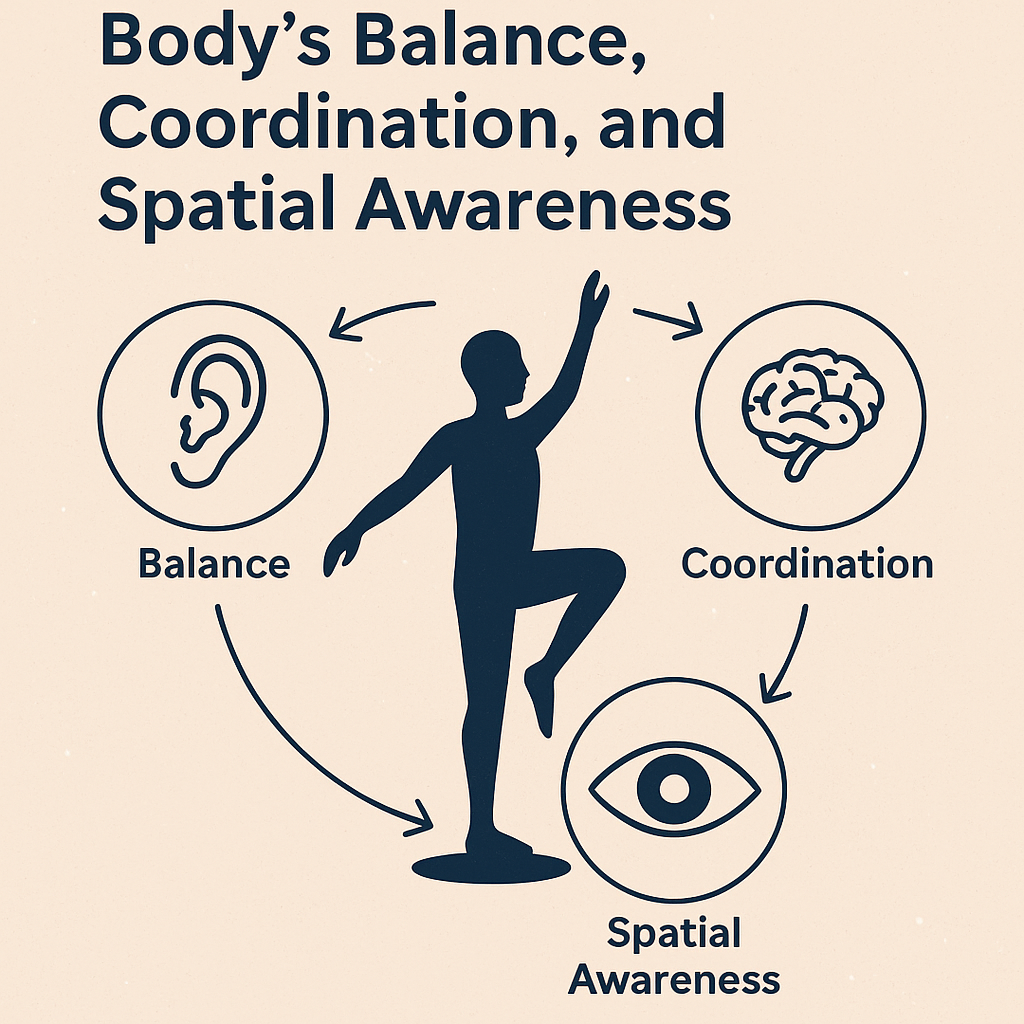
Achieving optimal balance, coordination, and spatial awareness is essential for physical performance, injury prevention, and everyday mobility. These core physiological abilities form the bedrock of how the human body navigates its environment, maintains posture, and executes complex movements. Below, we present a comprehensive breakdown of how these systems function, how they interrelate, and the most effective methods to improve them.
Understanding Body Balance: The Foundation of Movement
Balance is the body’s ability to maintain its center of gravity over its base of support. It involves a synchronized effort between the vestibular system, proprioceptors, visual input, and the musculoskeletal system.
There are two primary types of balance:
- Static Balance: Maintaining equilibrium while stationary (e.g., standing on one foot).
- Dynamic Balance: Sustaining stability while in motion (e.g., walking on uneven ground).
The vestibular system, located in the inner ear, detects changes in head position and motion. When combined with proprioceptive feedback—the body’s ability to sense joint position and movement—and visual cues, it enables the brain to make rapid, minute adjustments to prevent falling.
Coordination: Synchronizing Movement with Precision
Coordination refers to the smooth execution of movement patterns involving multiple body parts. It’s not simply about muscular strength or speed; it’s the capacity to engage the neuromuscular system efficiently and purposefully.
Types of coordination include:
- Hand-eye coordination: Crucial in sports and fine motor tasks.
- Bilateral coordination: Using both sides of the body harmoniously (e.g., running, swimming).
- Gross motor coordination: Managing large muscle groups in compound movements.
- Fine motor coordination: Control over small muscles, often in the fingers and hands.
Coordination relies heavily on motor planning, reaction time, and muscle memory. Enhanced coordination improves athletic performance, dexterity, and fluidity in everyday tasks like typing or cooking.
Spatial Awareness: Navigating the Environment Intelligently
Spatial awareness is the understanding of where the body is in relation to objects and the environment. It allows individuals to judge distances, depth, angles, and body positioning in real time. This skill is vital not only in sports but also in basic human interactions with the physical world—such as walking through a doorway or reaching for a cup without knocking it over.
The brain integrates visual, auditory, and proprioceptive signals to construct a real-time mental map of the surroundings. Improved spatial awareness results in fewer accidents, better posture, and faster reaction to external stimuli.
How Balance, Coordination, and Spatial Awareness Interconnect
These three systems are inseparably linked. A deficit in one often compromises the others. For instance, poor spatial awareness can throw off balance, and lack of coordination can lead to clumsy, inefficient movement patterns. When fully integrated, they enable:
- Agility and speed in athletes.
- Functional mobility in elderly individuals.
- Injury prevention across all age groups.
- Enhanced proprioceptive control during complex tasks.
Exercises to Enhance Balance, Coordination, and Spatial Awareness
1. Proprioceptive Drills
Balance boards, Bosu balls, and foam pads challenge the body’s awareness and response in unstable environments. Start with simple stances and progress to dynamic movements.
2. Cross-lateral Movements
Exercises like crawling, cross-body punches, or yoga poses (e.g., Bird-Dog) train both coordination and balance simultaneously.
3. Eye Tracking and Focus Exercises
Playing catch, juggling, or using light-reactive targets enhances hand-eye coordination and spatial judgment.
4. Agility Ladder Drills
Improve foot speed, reaction time, and the ability to shift weight quickly. These drills reinforce both coordination and dynamic balance.
5. Core Strengthening
A stable core underpins every balanced movement. Planks, dead bugs, and rotational exercises like Russian twists stabilize the torso and improve proprioception.
6. Tai Chi and Yoga
These disciplines cultivate a heightened awareness of body positioning and smooth, controlled transitions between poses that boost balance and coordination.
Daily Habits That Foster Neuromotor Control
- Limit sedentary behavior to reduce neural dulling of proprioceptors.
- Practice mindful movement by focusing on how your body feels during daily actions.
- Challenge your dominant side by brushing teeth or using utensils with the non-dominant hand.
- Incorporate play—dance, sports, martial arts—all naturally improve neuromotor skills.
Signs of Poor Balance and Coordination
Identifying deficiencies early can lead to more effective intervention. Warning signs include:
- Frequent tripping or stumbling
- Trouble with tasks like buttoning shirts or handwriting
- Difficulty following objects with the eyes
- Slow, uncoordinated body responses to external stimuli
If these issues persist, it may point to neurological impairment and professional evaluation is recommended.
Conclusion: Training the Body’s Navigational Intelligence
Balance, coordination, and spatial awareness form the triad of physical intelligence. Together, they dictate how safely and efficiently we move through the world. By integrating targeted training, mindful movement, and adaptive exercises into daily routines, we fortify our body’s innate ability to maintain stability, precision, and environmental intelligence.
This isn’t just about athletic enhancement—it’s about reclaiming full control over how we move, react, and thrive in every space we occupy.
Read More Articles: